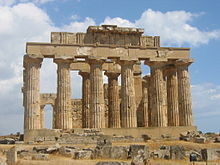architrave

From top to bottom: geison , frieze with triglyphs , architrave

The architrave ( Italian architrave ; from ancient Greek ἀρχι- archi- , German 'main' and Latin trabs 'beam' ) is a horizontal beam resting on a row of supports , usually the main beam supporting the superstructure. In ancient times, the architrave was also called the epistyle , as it was usually based on columns (Greek epi-styl means 'on columns').
The architrave distributes the load of the upper architectural elements , in particular the beams belonging to the roof structure , on pillars or pillars , but can also occur at the upper wall end.
A distinction is made between monolithic and multi-row architraves in which several blocks lie one behind the other. When dimensioning the architrave blocks, one went to the limits of what was technically feasible. For example, the central architrave block on the Temple of Artemis in Ephesus weighed 24 tons and had to be lifted to a height of over 20 meters using pulleys.
Architectural styles
The architrave already appears in Egyptian, Near Eastern and pre-Greek architecture and as a supporting or purely decorative element in all architectural styles that follow on from ancient architecture.
Depending on the architectural style, different designs of the architrave were used. Especially for the Doric and Ionic orders , various forms were developed in Greek architecture , which were later also used for the Corinthian order . The Roman architecture , however, modified the Greek Architravformen only slightly.
The Doric architrave is usually smooth and is crowned at its upper end by a protruding end strip called taenia . On the protruding underside of this taenia, in turn, small strips, regulae , are attached, from which conical drops, the guttae , hang. The number of these guttae is traditionally set at six, but especially in the early days of Doric stone architecture, four guttae were also found. The rules are distributed in such a way that one rule corresponds to each triglyph of the Doric triglyph frieze . Although the outside of the architrave should normally be smooth, there are exceptions in which the architrave supports figurative reliefs, for example at the Temple of Athena in Assos .
The originally very powerful and high architraves of Doric architecture become flatter in the course of development and in classical times only reached about two thirds of the lower column diameter in height. In Roman architecture, the Doric architrave can only be reduced to a flat plate.
The architrave of the Ionic and Corinthian orders can also be smooth, but usually has two or - classic - three horizontal stripes, so-called fascia. Depending on the case, one speaks of a two- or three-fascia architrave, and windows or doors that are surrounded by fascias are therefore also referred to as architraves . The upper fascia of the architrave jut slightly in front of the lower one. The upper end is formed by a wave profile, which is usually decorated with a string of pearls . In Ionic architecture, too, there are exceptions to the rule not to decorate the architrave surface with reliefs. For example, the architrave corners of the archaic Temple of Apollo in Didyma were decorated with gorgons , which were joined by lions on the sides. However, the early Ionic temple did not have a separate frieze as a structural component that could have received such reliefs.
From Hellenism onwards , the underside of Ionic architraves could be adorned, especially on buildings of the Corinthian order, which were filled with simple round bars or floral ornaments ( festoons ). From the late republic and in principle, the will of architects and builders to decorate also took hold of the fascia, the transitions of which are now covered with wave profiles, such as the lesbian kymation , and entire profile sequences.
literature
- Heiner Knell : Architecture of the Greeks (= basic features. Vol. 38). 2nd, improved edition. Scientific Book Society, Darmstadt 1988, ISBN 3-534-80028-1 .
- Wolfgang Müller-Wiener : Greek construction in antiquity. CH Beck, Munich 1988, ISBN 3-406-32993-4 .
- Gottfried Gruben : Greek temples and sanctuaries. 5th, completely revised and enlarged edition. Hirmer, Munich 2001, ISBN 3-7774-8460-1 .
